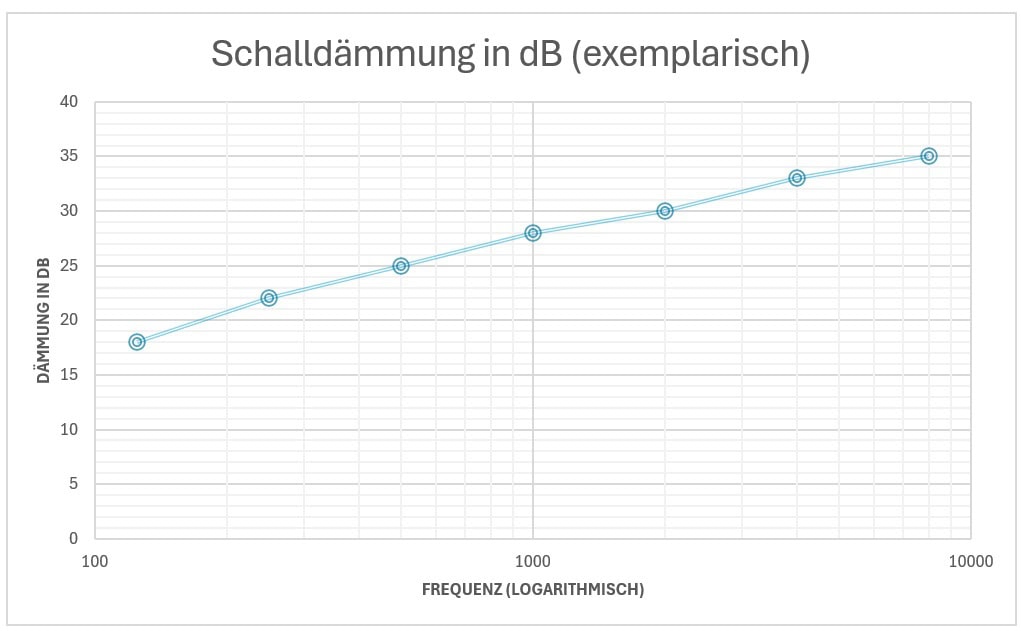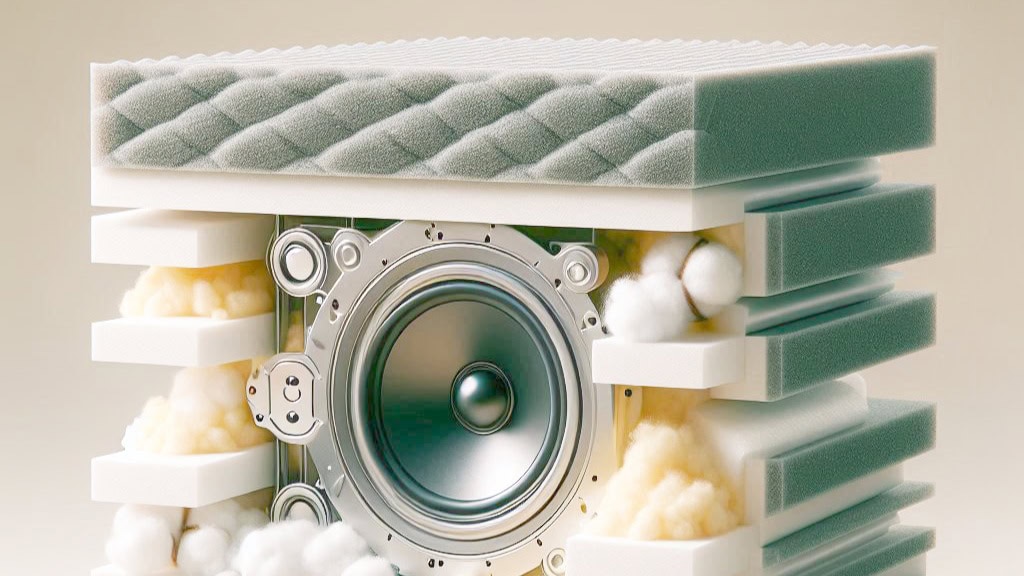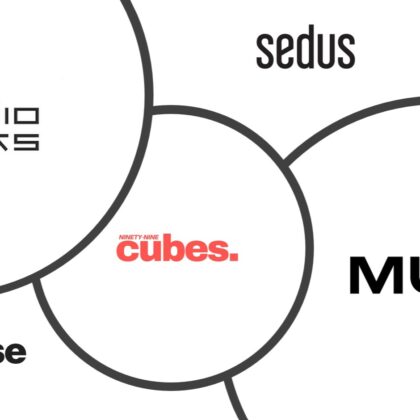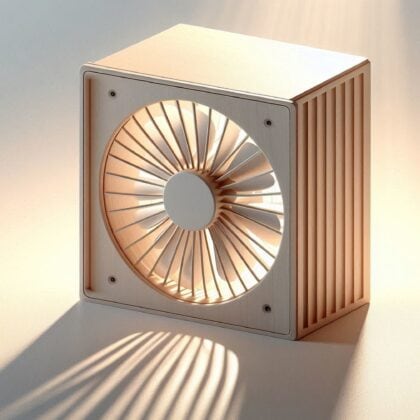Sound insulation is probably the most important function of an acoustic cube - unfortunately, however, the manufacturers' specifications can rarely be compared with each other. There are several reasons for this: The measurement methods are too different, and high figures are too tempting from a marketing perspective - even if they are achieved using the least suitable measurement methods.
We are trying to shed some light on the subject (background information) and have come up with our own scale based on the sound insulation classes of the ISO 23351-1:2020-06 standard.
Tip: If you want to make things easier, simply use the weight as a guide - this is actually a good indicator of sound insulation. You can find details here!
Contents
Sound insulation: What do values in decibels mean?
Decibels (dB) play a central role in the sound insulation of acoustic speakers as a unit of measurement for the effectiveness of sound insulation. To help you understand this, let's warm up with a few basics of acoustics:
- Logarithmic scale: & human hearing: The decibel scale is logarithmic and therefore takes into account the non-linear perception of volume by the human ear. An increase of 10 dB corresponds to a tenfold increase in sound intensity, while a reduction of 20 dB means a reduction by a factor of 100.
- Reference values: To get an approximate feeling for decibels, the following simplified scale can be used - to visualise the effect of 30 dB sound insulation, you can choose any line and jump down by 30 dB:
| Sound level in dB | Comparative value | Example with 30 dB sound insulation |
|---|---|---|
| 120 dB | Pain threshold | |
| 110 dB | Rock concert | |
| 100 dB | Circular saw | |
| 90 dB | classical concert | |
| 80 dB | heavy traffic, hoover | |
| 70 dB | Open-plan office | |
| 60 dB | normal conversation | That's how loud it is in the box |
| 50 dB | Quiet conversation | |
| 40 dB | Refrigerator | |
| 30 dB | Whisper | This is what it sounds like in front of the box |
| 20 dB | Quiet in the radio studio | |
| 10 dB | Snowfall |
What does this mean in practice? The example in the table shows that a conversation held in a meeting box at normal volume is reduced to a whisper by 30 dB of insulation. However, whether the whisper is actually perceived outside depends on the ambient noise level: If the meeting box is located in a fully occupied open-plan office, you are unlikely to notice a whisper - especially if you are standing or sitting a few metres away from the box. The situation is different, however, if the same box is located in a museum where the background noise is greatly reduced.
Tip: We have integrated a small sound insulation simulator on our website, which you can use to visualise the effect of different decibel values: Click here for our mini-simulator for sound insulation in decibels.
Measurement methods: Why are decibels not equal to decibels?
There is actually no "one" decibel value for an acoustic cube - there are various reasons for this:
- Frequency dependence: The sound insulation of acoustic cubes depends on the sound frequency. Low tones are less well insulated than high tones. Professionals therefore normally specify sound insulation values for different frequency ranges in order to give a comprehensive picture of the performance. The "one" sound insulation value therefore only exists as an average value across different frequencies.

- Directionality: The direction of measurement plays a significant role in sound insulation. In most acoustic cubes, the acoustically more effective insulating material is installed on the inside (acoustic fleece, textiles and foams, etc.), while materials such as wood, melamine or metal are used on the outside, which are more for stability. Therefore, the sound insulation measured from the inside to the outside is usually better than the other way round. Once again, professionals specify the direction of measurement for sound insulation.
- Individual component or entire cube? A relatively dubious method of specifying the insulation performance of an acoustic cube is to state the sound insulation values of an individual component, e.g. a side wall. Everyone should decide for themselves what value should be attached to such information - classic weak points in sound insulation, such as the quality of the door seal, cannot be depicted with this value, although this may be decisive for the overall acoustic effect. As an excuse, it should be noted that acoustic measurements of a complete speaker in the laboratory are relatively expensive and are therefore not necessarily carried out again by the manufacturers with every model revision or every model variant.
At Ninty-Nine-Cubes, we see it as part of our job as a supplier to hold the manufacturers we select accountable for checking and categorising their specifications. As a simple guide, we have therefore developed our own scale for sound insulation: from ★☆☆☆☆ to ★★★★★
So what should you look out for in decibel specifications for acoustic cubes? We at Ninty-Nine-Cubes would first of all like to sensitise you not to be dazzled by visually high decibel figures. The values are difficult to compare, the same standard is not always used as a basis for the measurement and in some cases, the decibel values are somewhat different. If in doubt, a look at the weight specifications for the box and a comparison with other models and manufacturers will help (see the greatly underestimated parameter "Weight").
Which standards are relevant for the sound insulation of acoustic cubes?
In addition to the previously mentioned difficulties in obtaining meaningful information on sound insulation, there is another challenge: the world of DIN / EN / ISO standards is currently still causing some confusion. To be more precise, different manufacturers use different standards to determine their sound insulation. This is partly for historical reasons - anyone who carried out certification before 2020/2021 could not yet refer to the latest standards - and partly for reasons that are incomprehensible to us. In any case, the following standards were and are used and referred to:
- ISO 23351-1:2020-06: Acoustics - Measurement of speech sound pressure level reduction of furniture assemblies and enclosures - Part 1: Laboratory method
- DIN EN ISO 11957:2010-01: Acoustics - Measuring the sound insulation of soundproof cabins - Measurements in the laboratory and in the field
- DIN EN ISO 16283-1:2018-04: Acoustics - Measurement of sound insulation in buildings and of building elements - Part 1: Airborne sound insulation
- DIN EN ISO 717-1:2021-05: Acoustics - Evaluation of sound insulation in buildings and of building elements - Part 1: Airborne sound insulation
The relatively new ISO standard from 2020 defines several sound insulation classes with values between class A+ and class D - in other words, similarly categorised to the much better-known energy efficiency classes used for household appliances. Classes A+, A and B ensure speech privacy in typical office environments, while classes C and D may offer sufficient protection depending on the background noise level in the office:
| Sound insulation classes | Speech level reduction | Star classification Ninty-Nine-Cubes* | Use |
|---|---|---|---|
| Class A+ | > 33 dB | ★★★★★ | Recording studio | Industry |
| Class A | 30-33 dB | ★★★★☆ | noisy office |
| Class B | 25-30 dB | ★★★☆☆ | normal office |
| Class C | 20-25 dB | ★★☆☆☆ | Conditionally suitable |
| Class D | 15-20 dB | ★☆☆☆☆ |
Questions, comments & personal advice
Are you missing any information or do you have any questions? Then please leave a comment below! You can also get free advice from us:




